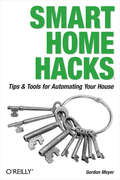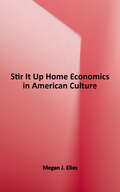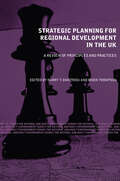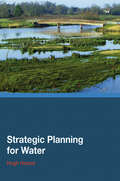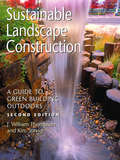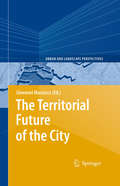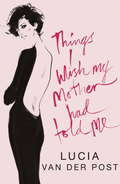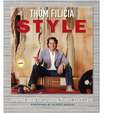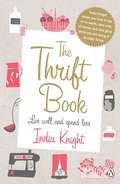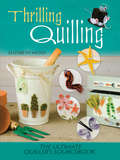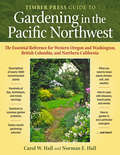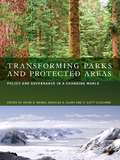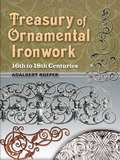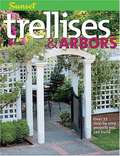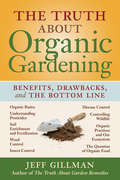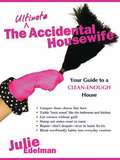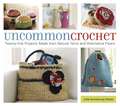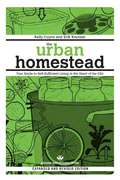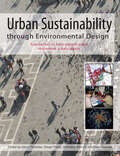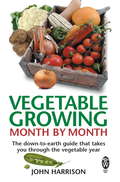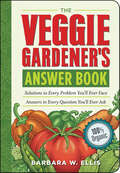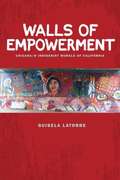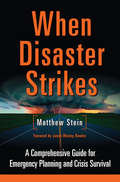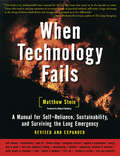- Table View
- List View
Smart Home Hacks
by Gordon MeyerSo much of what is commonplace today was once considered impossible, or at least wishful thinking. Laser beams in the operating room, cars with built-in guidance systems, cell phones with email access. There's just no getting around the fact that technology always has, and always will be, very cool. But technology isn't only cool; it's also very smart. That's why one of the hottest technological trends nowadays is the creation of smart homes. At an increasing rate, people are turning their homes into state-of-the-art machines, complete with more switches, sensors, and actuators than you can shake a stick at. Whether you want to equip your home with motion detectors for added security, install computer-controlled lights for optimum convenience, or even mount an in-home web cam or two purely for entertainment, the world is now your oyster. Ah, but like anything highly technical, creating a smart home is typically easier said than done. Thankfully, Smart Home Hacks takes the guesswork out of the process. Through a seemingly unending array of valuable tips, tools, and techniques, Smart Home Hacks explains in clear detail how to use Mac, Windows, or Linux to achieve the automated home of your dreams. In no time, you'll learn how to turn a loose collection of sensors and switches into a well-automated and well-functioning home no matter what your technical level may be. Smart Home Hacks covers a litany of stand-alone and integrated smart home solutions designed to enhance safety, comfort, and convenience in new and existing homes. Kitchens, bedrooms, home offices, living rooms, and even bathrooms are all candidates for smart automation and therefore are all addressed in Smart Home Hacks. Intelligently written by engineering guru and George Jetson wannabe, Gordon Meyer, Smart Home Hacks leaves no stone unturned. From what to purchase to how to use your remote control, it's the ultimate guide to understanding and implementing complete or partial home automation.
Stir It Up: Home Economics in American Culture
by Megan J. EliasFor Americans who came of age in the mid-twentieth century, home economics conjures memories of burnt toast and sewing disasters. But as historian Megan Elias shows in Stir It Up, home economics began as an idealistic reform movement in higher education in the early 1900s. Leaders of this movement sought to discover and disseminate the best methods for performing domestic work while creating new professional options for women that were based on elements of home life. Home and family were treated as subjects for scientific analysis; students wore lab coats while baking bread and performed rigorous tests on the palatability of their work. The Federal Bureau of Home Economics supplied a grateful audience with informational bulletins as Americans seemed to accept the idea that home could be a site for social change. <p><p>A major shift occurred in the 1950s, when new ideas about women's roles seemed to divert home economics into more traditional channels, and "home ec" became identified with the era's conformist culture. Even as home economists were redefining family dynamics and influencing government policies, such as school lunch programs, their field was becoming an object of scorn, especially to the feminists of the 1960s. Stir It Up explains what the successes and failures of home economists can tell us about American culture. The book concludes with an examination of contemporary attitudes toward domesticity, putting the phenomena of Martha Stewart, Rachael Ray, Ty Pennington, and the "Mommy Wars" into historical context.
Strategic Planning for Regional Development in the UK (Natural and Built Environment Series)
by Harry T. Dimitriou Robin ThompsonWith contributions from leading academics and practitioners, Strategic Planning for Regional Development in the UK is the most up-to-date treatment of a fast-changing subject. The book discusses: The evolution of regional planning in the UK and the strategic thinking involved The spatial implications of regional economic development policies The methods and techniques needed for the implementation of strategic planning for regional development How strategic planning for regional development is currently put into practice in three UK regions with different priorities. Strategic Planning for Regional Development in the UK is essential reading for students and academics working within strategic and regional planning and provides policy makers and practitioners with a comprehensive and thought provoking introduction to this critically important emerging field.
Strategic Planning for Water
by Hugh HowesStrategic Planning for Water examines the neglected relationship between planning for water and spatial planning. It provides the background to sustainable water management and assistance to spatial planners in understanding the complex water environment. This extremely topical book examines the challenges of:how to ensure that water supplies are a
Sustainable Landscape Construction: A Guide to Green Building Outdoors, Second Edition
by J. William Thompson Kim SorvigPublished at the beginning of the twenty-first century, Sustainable Landscape Construction took a new approach to what was then a nearly new subject: how to construct outdoor environments based on principles of sustainability. This enormously influential book helped to spur a movement that has taken root around the U.S. and throughout the world. The second edition has been thoroughly updated to include the most important developments in this landscape revolution, along with the latest scientific research in the field. It has been expanded to provide even more ideas for designing, building, and maintaining environmentally sensitive landscapes. It is essential reading for everyone with an interest in "green" landscape design. Like its predecessor, the new edition of Sustainable Landscape Construction is organized around principles that reflect the authors' desire to put environmental ethics into practice. Each chapter focuses on one over-arching idea. These principles of sustainability are clearly articulated and are developed through specific examples. More than 100 projects from around the globe are described and illustrated. A new chapter details ways in which landscape architectural practice must respond to the dangers posed by fire, floods, drought, extreme storms, and climate change. Sustainable Landscape Construction is a crucial complement to basic landscape construction texts, and is a one-of-a-kind reference for professionals, students, and concerned citizens.
The Territorial Future of the City
by Giovanni MacioccoThe volume brings together contributions by leading scholars and young academics with experience in the urban potential of the territory in situations not necessarily linked to the dense metropolis, its compact form or to city sprawl. What brings these scholars together is their common reflection on this central theme, though from varied disciplinary and experimental backgrounds. They offer new forms of representing social and spatial processes of the contemporary society.
Things I Wish My Mother Had Told Me: Lessons in Grace and Elegance
by Lucia Van Der PostPacked full of golden rules from one of Britain's most stylish women, Things I Wish My Mother Had Told Me is a woman's companion for life. Lucia van der Post reveals the secrets of dressing stylishly with advice on everything from how to organise your wardrobe, what to wear to travel and where to buy delicious underwear, great cashmere and sassy skirts. Practical health and beauty tips will help you to choose a sophisticated scent, get fitter and decide whether cosmetic surgery is for you.Once you've mastered looking fantastic, learn how to add some elegance to other areas of your life. Discover great shortcuts to entertaining your guests as well as suggestions, from designers around the world, on how to make your home match the elegant new you. With advice on relationships, motherhood and how to juggle work, love and children, this is the essential handbook for women of all ages. Whether you are just starting out in life or want to age gracefully and make 60 the new 40, let Lucia van der Post guide you towards a new life and a new you with a touch of style.
Thom Filicia Style
by Thom Filicia"I'm a democratic design snob. I see it as my mission to help stamp out boring, unimaginative interiors. But I also love people, having fun, and what I do for a living. I think a fabulously styled place is achievable by everyone. Think of me as your decorating wingman." Thom Filicia, whose one-of-a-kind makeover genius gained national attention through his starring roles on Queer Eye for the Straight Guy and Dress My Nest, offers the ultimate handbook for creating gorgeous interiors that showcase your unique personal style. Those who have witnessed Thom's remarkable makeovers on television already know about the much-anticipated reveal moment when the emotionally overwhelmed homeowners are struck speechless by the miracle he has created. The same miracle is now possible for your home, with the secrets and tips contained in Thom Filicia Style. With his trademark wit and friendly voice, Thom deconstructs how he works his magic and provides pages of invaluable advice, inspiration, before-and-after photos, case studies, floor plans, and product information. His approach will help you elevate your personal aesthetic by strategizing the best ways to make the most out of every space. From his work on a Manhattan loft to a suburban family home, Thom brings a fresh and invigorating vision to the way we live -- a vision that can apply to homes and decorating budgets of any size. Demystifying the decorating process one step at a time, Thom has filled this guide with everything you need to create the perfect interior. Thom Filicia Style is like having the designer himself on hand to take care of all the details.
The Thrift Book: Live Well and Spend Less
by India KnightThe Thrift Book is a guide to how to live well while spending less by bestselling writer India Knight.Feeling poor because of the credit crunch? Feeling guilty because of global warming? Feeling like you'd like to tighten your belt, but aren't ready to embrace DIY macramé handbags? No need to panic. Put down the economy mince and buy this book instead - it's a blueprint for living beautifully, while saving money and easing your conscience. India Knight will show you:- How to make wonderful dinners with every little money- How to dress on a budget and still look fabulous- How to make friends and start sharing with your neighbours- How to holiday imaginatively - with barely a carbon footprintTry it - you have nothing to lose but your overdraft.'A blueprint for living well, however broke you are, with thrifty tips on looking fab, cooking, pampering and partying' Cosmopolitan'The Thrift Book might be the only sure-fire investment out there' Harper's Bazaar'A triumphant treat and a useful and sensible manual' IndependentIndia Knight is the author of four novels: My Life on a Plate, Don't You Want Me, Comfort and Joy and Mutton. Her non-fiction books include The Shops, the bestselling diet book Neris and India's Idiot-Proof Diet, the accompanying bestselling cookbook Neris and India's Idiot-Proof Diet Cookbook and The Thrift Book. India is a columnist for the Sunday Times and lives in London with her three children.Follow India on Twitter @indiaknight or on her blog at http://indiaknight.tumblr.com.
Thrilling Quilling: The Ultimate Quiller's Sourcebook
by Elizabeth Moad"This book is an excellent sourcebook for quilling and I recommend anyone interested in paper craft to own this book." -- Doodles in the Margin ReviewsAdd pizzazz to picture frames, notebooks, vases, boxes, bags, or any everyday item that could use a decorative touch. The centuries-old craft of quilling involves rolling, shaping, and gluing strips of paper into ornamental designs. It's easy to learn, and this guide is bursting with simple, step-by-step instructions and colorful illustrations that will get you started and send you on your way with a wealth of new possibilities.From quick and easy individual motifs to larger, more elaborate combinations, here are more than 100 designs with countless applications. Quilling requires very little equipment and few materials -- just an inexpensive investment in a manual quilling tool, glue, and paper. With a little practice, you'll master the techniques of coiling, pinching, fringing, weaving, and husking. Then you'll be able to add a personal touch to cards, gifts, and other items. In addition, the book features galleries of imaginative ideas that will provide further inspiration and encourage you to develop new ideas and creative approaches.
The Timber Press Guide to Gardening in the Pacific Northwest: The Essential Reference For Western Oregon And Washington, British Columbia, And Northern California
by Carol W. Hall Norman E. HallTired of being lumped into the unwieldy category of a western garden? Frustrated by the lack of reliable, practical information about gardening in the Pacific Northwest? No longer! The Timber Press Guide to Gardening in the Pacific Northwest presents all the information a gardener—whether novice or expert—needs to keep their garden beautiful and thriving. With a combined 100 years of gardening experience in the Pacific Northwest, the authors clearly explain the unique challenges and joys of gardening in the region. By dividing the Pacific Northwest into seven subregions, they help readers to better understand the climatic and geographical factors that shape their gardens. This complete guide includes extensive profiles of plants that are ideally suited to the region, including perennials, ornamental grasses, bulbs, groundcovers, roses, shrubs, trees, and climbers. The month-by-month gardening calendar describes what weather patterns to expect, what's in bloom, and what garden tasks are best done in that month. With additional chapters detailing the most common gardening problems and recommendations for effective, nontoxic ways of dealing with them, this book is nothing short of essential.
Transforming Parks and Protected Areas: Policy and Governance in a Changing World
by Kevin S. Hanna Douglas A. Clark D. Scott Slocombe**This title was originally published in 2007. The version published in 2012 is a PB reprint of the original HB** The protection of natural resources and biodiversity through protected areas is increasingly based on ecological principles. Simultaneously the concept of ecosystem-based management has become broadly accepted and implemented over the last two decades. However, this period has also seen unprecedented rapid global social and ecological change, which has weakened many protection efforts. These changes have created an awareness of opportunities for innovative approaches to managing protected areas and of the need to integrate social and economic concerns with ecological elements in protected areas and parks management. A rare collection of articles that fuses academic theory, critique of practice and practical knowledge, Transforming Parks and Protected Areas analyzes and critiques these theories, practices, and philosophies, looking in-detail at the emerging issues in the design and operation of parks and protected areas. Addressing critical dynamics and current practices in parks and protected areas management, the excellent volume goes well beyond simple managerial solutions and descriptions of standard practice. With contributions from leading academics and practitioners, this book will be of value to all those working within ecology, natural resources, conservation and parks management as well as students and academics across the environmental sciences and land use management.
Treasury of Ornamental Ironwork: 16th to 18th Centuries
by Adalbert RoeperSixty vintage black-and-white plates illustrate the history of German decorative ironwork from the16th to the 18th centuries. A hard-to-find celebration of the diversity and enduring beauty of Germany's handcrafted iron embellishments, this magnificent edition exhibits striking views of metal doors, balconies, window arches, gates, corner pieces, decorative accessories, and more, many wrought with gargoyles, human figures, and florals. A rich source of inspiration and an accurate, invaluable reference for art historians, architects, craftworkers, and designers.
Trellises And Arbors
by Steve Cory Sunset Publishing StaffThere are so many reasons readers will get attached to this new edition of Sunset's best-selling "Trellises & Arbors". For starters, it's all new, and expanded with 32 pages and over 250 brand-new photographs, many of which show how other homeowners have used obelisks, arbor benches, eye-catching latticework, and vegetable supports to provide privacy, form outdoor rooms, frame garden paths, and give climbing vines and roses a place to thrive. Then there are the projects themselves--more than 40 in all, ranging from a simple fan trellis to a dramatic tunnel arbor, giving builders of all skill levels a range of ways to create stunning garden focal points. Best of all, these projects use standard-dimension lumber and don't require special woodworking skills. Features: expanded edition with 32 additional pages, over 250 new how-to photographs, over 40 projects for beginning to advanced woodworkers, classic trellis and arbor designs that enhance any setting, and a new techniques chapter with information on safety, cutting methods, setting posts, and pouring concrete.
The Truth About Organic Gardening: Benefits, Drawnbacks, and the Bottom Line
by Jeff GillmanGardeners tend to assume that any organic product is automatically safe for humans and beneficial to the environment—and in most cases this is true. The problem, as Jeff Gillman points out in this fascinating, well-researched book, is that it is not always true, and the exceptions to the rule can pose a significant threat to human health. To cite just one example, animal manures in compost can be a source of harmful E. coli contamination if imporperly treated. Gillman's contention is that all gardening products and practices—organic and synthetic—need to be examined on a case-by-case basis to determine both whether they are safe and whether they accomplish the task for which they are intended.Ultimately, Gillman concludes, organic methods are preferable in most situations that gardeners are likely to encounter. After reading this eye-opening book, you will understand why, and why knowledge is the gardener's most important tool.
The Ultimate Accidental Housewife: Your Guide to a Clean-Enough House
by Julie EdelmanBestselling author Julie Edelman returns with an essential guide about how to get your house clean--or, even better, just clean enough! Accessible, easy to read, and entertaining, The Ultimate Accidental Housewife(tm) gives you fun, simple solutions to all kinds of common household problems, from scrubbing the stove to spotting those stubborn laundry stains. With plenty of useful tips and tricks for cleaning your house just enough, this accidentally domestic diva offers practical advice you'll use every day--without ever spoiling your manicure. Find out how to: Limit your daily workload with defensive cleaning and organizing Handle "toxic zones" like the bathroom and kitchen "Fix" problems until the repairman comes Remove aggressive stains This must-have little volume splits housekeeping into two categories: Toxic Zones include the bathrooms and kitchen, since they have the greatest chance of housing living organisms that multiply or smell. Not So Toxic Zones include the bedrooms, living room, and family rooms, where dust bunnies are your biggest foe. In addition, helpful sections like I Never Knew You Could Do That! include myriad uses for ordinary household products, and The United Stains Across America, an Accidental favorite, is the most patriotic stain guide you'll ever see. With Julie's trademark inventiveness and good humor, The Ultimate Accidental Housewife is a sanity-saver for overextended women everywhere.
Uncommon Crochet: Twenty-Five Projects Made from Natural Yarns and Alternative Fibers
by Julie Armstrong HoletzBlack leather granny squares are anything but square, and hot pink organic hemp gives crocheted vases a decidedly modern cachet. In Uncommon Crochet, designer Julie Armstrong Holetz applies new ideas and unconventional materials--like wire, raffia, jute, sisal, recycled belts, fabric strips, and felted beads--to twenty-five patterns for bins, baskets, totes, handbags, clutches, jewelry, and more. Step-by-step instructions, detailed how-to photographs, and essential advice about creativity, design, and experi-mentation encourage you to play with fiber, add funky embellishments, and use your creative spirit to customize any pattern--even the ones in this book! From practical containers like Red's Goodie Basket (a stylish home for your WIP--works in progress) and Vintage Satchel (a sturdy retro messenger bag) to just plain fun projects like Petite Fleur Vases (tiny bud vases that hold water) and Sushi (crocheted California rolls, anyone?), Uncommon Crochet offers fresh twists on old-school techniques that turn simple projects into gift-worthy creations.
The Urban Homestead (Expanded & Revised Edition)
by Kelly Coyne Erik KnutzenThe expanded, updated version of the best-selling classic, with a dozen new projects."A delightfully readable and very useful guide to front- and back-yard vegetable gardening, food foraging, food preserving, chicken keeping, and other useful skills for anyone interested in taking a more active role in growing and preparing the food they eat."-BoingBoing.net"...the contemporary bible on the subject."-The New York TimesThis celebrated, essential handbook shows how to grow and preserve your own food, clean your house without toxins, raise chickens, gain energy independence, and more. Step-by-step projects, tips, and anecdotes will help get you started homesteading immediately. The Urban Homestead is also a guidebook to the larger movement and will point you to the best books and Internet resources on self-sufficiency topics.Written by city dwellers for city dwellers, this copiously illustrated, two-color instruction book proposes a paradigm shift that will improve our lives, our community, and our planet. By growing our own food and harnessing natural energy, we are planting seeds for the future of our cities.Learn how to:Grow food on a patio or balconyPreserve or ferment food and make yogurt and cheeseCompost with wormsKeep city chickensDivert your grey water to your gardenClean your house without toxinsGuerilla garden in public spacesCreate the modern homestead of your dreams
Urban Sustainability Through Environmental Design: Approaches to Time-People-Place Responsive Urban Spaces
by Kevin Thwaites Sergio Porta Ombretta Romice Mark GreavesWhat can architects, landscape architects and urban designers do to make urban open spaces, streets and squares, more responsive, lively and safe? Urban Sustainability through Environmental Design answers this question by providing the analytical tools and practical methodologies that can be employed for sustainable solutions to the design and management of urban environments. The book calls into question the capability of ‘quick-fix’ development solutions to provide the establishment of fixed communities and suggests a more time-conscious and evolutionary approach. This is the first significant book to draw together a pan-European view on sustainable urban design with a specific focus on social sustainability. It presents an innovative approach that focuses on the tools of urban analysis rather than the interventions themselves. With its practical approach and wide-ranging discussion, this book will appeal to all those involved in producing communities and spaces for sustainable living, from students to academics through to decision makers and professional leaders.
Vegetable Growing Month-by-Month: The down-to-earth guide that takes you through the vegetable year
by John HarrisonWhatever the size of your garden or allotment, you can grow your own vegetables. Even if you only have a balcony or a small paved area outside your kitchen, you can grow more than you ever thought possible in pots, containers and raised beds.Experienced vegetable grower John Harrison takes you through the entire vegetable year so that, for all the main vegetables, you'll know exactly when you should sow your seeds, dig your plot and harvest your crops.Choose the most appropriate vegetables for your particular soil and select the right position so that they flourish. Discover how to make your own compost and organic fertilisers, as well as the best methods of controlling pests. Find out how to extend the season by buying or building your own cloches and cold frames.Put an end to worries that your shop-bought vegetables contain chemical residues or to concerns about the air miles such vegetables have flown en route to your table!
Vegetable Growing Month-by-Month: The down-to-earth guide that takes you through the vegetable year
by John HarrisonWhatever the size of your garden or allotment, you can grow your own vegetables. Even if you only have a balcony or a small paved area outside your kitchen, you can grow more than you ever thought possible in pots, containers and raised beds.Experienced vegetable grower John Harrison takes you through the entire vegetable year so that, for all the main vegetables, you'll know exactly when you should sow your seeds, dig your plot and harvest your crops.Choose the most appropriate vegetables for your particular soil and select the right position so that they flourish. Discover how to make your own compost and organic fertilisers, as well as the best methods of controlling pests. Find out how to extend the season by buying or building your own cloches and cold frames.Put an end to worries that your shop-bought vegetables contain chemical residues or to concerns about the air miles such vegetables have flown en route to your table!
The Veggie Gardener's Answer Book: Solutions to Every Problem You'll Ever Face; Answers to Every Question You'll Ever Ask (Answer Book Ser.)
by Barbara W. EllisBarbara Ellis provides expert answers for all of your toughest vegetable-growing questions. Designed to be used as an in-the-garden reference, this sturdy little volume is packed with helpful information on everything from planning a garden and sowing seeds to battling pests and harvesting organic crops. With clever tricks to cut down on weed growth, secrets for maximizing production in confined growing spaces, and fail-safe watering guidelines, you’ll have the know-how and inspiration to grow your most abundant vegetable garden ever.
Walls of Empowerment
by Guisela LatorreExploring three major hubs of muralist activity in California, where indigenist imagery is prevalent, Walls of Empowerment celebrates an aesthetic that seeks to firmly establish Chicana/o sociopolitical identity in U. S. territory. Providing readers with a history and genealogy of key muralists' productions, Guisela Latorre also showcases new material and original research on works and artists never before examined in print. An art form often associated with male creative endeavors, muralism in fact reflects significant contributions by Chicana artists. Encompassing these and other aspects of contemporary dialogues, including the often tense relationship between graffiti and muralism, Walls of Empowerment is a comprehensive study that, unlike many previous endeavors, does not privilege non-public Latina/o art. In addition, Latorre introduces readers to the role of new media, including performance, sculpture, and digital technology, in shaping the muralist's "canvas. " Drawing on nearly a decade of fieldwork, this timely endeavor highlights the ways in which California's Mexican American communities have used images of indigenous peoples to raise awareness of the region's original citizens. Latorre also casts murals as a radical force for decolonization and liberation, and she provides a stirring description of the decades, particularly the late 1960s through 1980s, that saw California's rise as the epicenter of mural production. Blending the perspectives of art history and sociology with firsthand accounts drawn from artists' interviews, Walls of Empowerment represents a crucial turning point in the study of these iconographic artifacts.
When Disaster Strikes
by Matt SteinThis well written guide provides instruction on making sure your needs are met for food, water, first aid and self-defense in any crisis. Specific instructions for handling seven types of disasters, from fire and earthquakes to electromagnetic pulses and solar storms are provided. Useful figures appear throughout, and the book closes with recommended reading and resources. Stein is an avid outdoorsman and green builder. Annotation ©2012 Book News, Inc. , Portland, OR (booknews. com)
When Technology Fails
by Matthew SteinThere's never been a better time to "be prepared. " Matthew Stein's comprehensive primer on sustainable living skills-from food and water to shelter and energy to first-aid and crisis-management skills-prepares you to embark on the path toward sustainability. But unlike any other book, Stein not only shows you how to live "green" in seemingly stable times, but to live in the face of potential disasters, lasting days or years, coming in the form of social upheaval, economic meltdown, or environmental catastrophe. "When Technology Fails" covers the gamut. You'll learn how to start a fire and keep warm if you've been left temporarily homeless, as well as the basics of installing a renewable energy system for your home or business. You'll learn how to find and sterilize water in the face of utility failure, as well as practical information for dealing with water-quality issues even when the public tap water is still flowing. You'll learn alternative techniques for healing equally suited to an era of profit-driven malpractice as to situations of social calamity. Each chapter (a survey of the risks to the status quo; supplies and preparation for short- and long-term emergencies; emergency measures for survival; water; food; shelter; clothing; first aid, low-tech medicine, and healing; energy, heat, and power; metalworking; utensils and storage; low-tech chemistry; and engineering, machines, and materials) offers the same approach, describing skills for self-reliance in good times and bad. Fully revised and expanded-the first edition was written pre-9/11 and pre-Katrina, when few Americans took the risk of social disruption seriously-"When Technology Fails" ends on a positive, proactive note with a new chapter on "Making the Shift to Sustainability," which offers practical suggestions for changing our world on personal, community and global levels.
